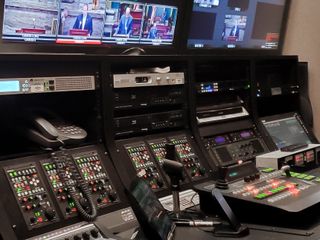The Senate Video Facility at the Senate of Pennsylvania provides citizens with government transparency through gavel-to-gavel television coverage of Senate sessions plus select committee meetings and public hearings. Wanting to enhance accessibility for hard-of-hearing individuals, the Senate chose the enCaption system from ENCO to provide automated closed captioning for its TV operations. enCaption has also enabled the Senate to provide in-room open captions for hard-of-hearing meeting participants on an as-needed basis.
[AV Designers and Integrators Discuss ADA Compliance]
The Senate’s initial closed captioning efforts many years ago pulled data from the court reporter’s transcription system, but the technology was not sufficiently mature and the results were unreliable. The closed captioning initiative came back to the forefront years later, with both the majority and minority leaders wanting to make the sessions more accessible to constituents.
The Senate Video Facility first considered using a captioning service provider with human transcribers, but ongoing scheduling challenges proved problematic. “With such services, we would need to book captioners in advance,” explained Dave Costanza, the CBNT (Certified Broadcast Networking Technologist) engineer who heads up the Senate’s broadcasting operations. “But while our sessions officially have scheduled start times, other scheduling variables made that option undesirable.”
Automated, Alternative Approach

Costanza had already discovered an alternative approach, having previously seen an early version of enCaption. Hard of hearing himself, he has a personal appreciation for captioning and had made a mental note of the solution. The Senate team requested an evaluation unit of enCaption to try in the Chamber, and with it working successfully and proving less costly than live captioners, decided to keep it.
The Senate Video Facility has since expanded to using four enCaption systems, spanning the Chamber and three hearing rooms. Each space has remotely controlled cameras feeding video switchers, with the program audio feed routed to the enCaption system. The resulting captions are fed to an external encoder for incorporation into the final video signal, which in turn is sent to government and public affairs channel Pennsylvania Cable Network (PCN) for distribution throughout the state.
“Our workflow couldn’t get much simpler,” said Costanza. “We just take the audio of our program out and feed it right into enCaption, and away it goes.”
From “On Television” to “In-Room AV”
The Senate Video Facility has also put enCaption to work for its occasional in-room captioning needs, including the Senate’s annual budget hearings. One of the participants who regularly testifies at the meetings is hard of hearing, leading to the need for openly displayed captions. “We had previously handled this through a service provider but faced the same type of scheduling issues, and they also needed an internet connection in the room,” explained Costanza. “Now, our caption encoder can output both open and closed captions from the data that enCaption sends it, so we display the open captions on large monitors that face the audience in the room.”










